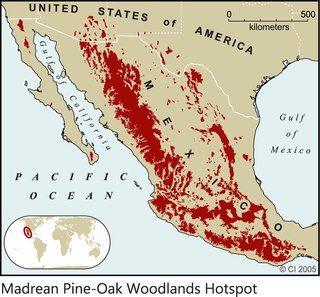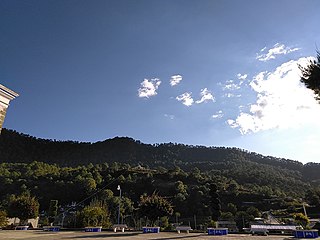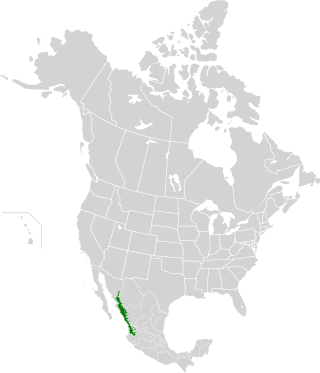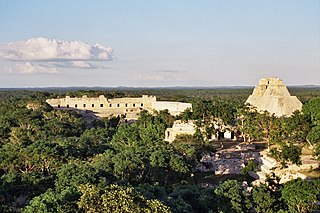
The Sierra Madre del Sur is a mountain range in southern Mexico, extending 1,000 kilometres (620 mi) from southern Michoacán east through Guerrero, to the Isthmus of Tehuantepec in eastern Oaxaca.

The Madrean pine–oak woodlands are subtropical woodlands found in the mountains of Mexico and the southwestern United States. They are a biogeographic region of the tropical and subtropical coniferous forests and temperate broadleaf and mixed forests biomes, located in North America.

The Sierra de la Laguna dry forests are a subtropical dry forest ecoregion of the southern Baja California Peninsula in Mexico.

The Sierra Madre Occidental pine–oak forests are a Temperate broadleaf and mixed forests ecoregion of the Sierra Madre Occidental range from the southwest USA region to the western part of Mexico. They are home to a large number of endemic plants and important habitat for wildlife.

The Sierra Madre de Oaxaca pine–oak forests is a tropical and subtropical coniferous forests ecoregion in Southern Mexico.

The Petén–Veracruz moist forests is an ecoregion of the tropical and subtropical moist broadleaf forest biome found in Belize, Guatemala, and Mexico.

The Veracruz moist forests is a tropical moist broadleaf forests ecoregion in eastern Mexico.

The Balsas dry forests is a tropical dry broadleaf forest ecoregion located in western and central Mexico.

The Sonoran–Sinaloan transition subtropical dry forest is a tropical dry broadleaf forest ecoregion in northwestern Mexico.

The Sierra Madre del Sur pine–oak forests is a subtropical coniferous forest ecoregion in the Sierra Madre del Sur mountain range of southern Mexico.

The Chiapas Depression dry forests form one of the ecoregions that belong to the tropical and subtropical dry broadleaf forests biome, as defined by the World Wildlife Fund, in northwestern Central America.

The Sinaloan dry forests is a tropical dry broadleaf forest ecoregion in western Mexico. It is the northernmost ecoregion of the Neotropical realm.

The Jalisco dry forests is a tropical dry broadleaf forest ecoregion in southwestern Mexico.

The Oaxacan montane forests is a tropical moist broadleaf forest ecoregion in eastern Mexico. It includes a belt of montane tropical forest on the eastern slope of the Sierra Madre de Oaxaca and eastern Trans-Mexican Volcanic Belt ranges. These forests lie between the lowland Petén–Veracruz moist forests and Veracruz moist forests, and the pine–oak forests of the higher mountains.

The Chimalapas montane forests is a tropical moist broadleaf forest ecoregion in southern Mexico. It includes the montane tropical forests of the Chimalapas region on the boundary of Chiapas and Oaxaca.

The Sierra Madre de Chiapas moist forests is a tropical moist broadleaf forest ecoregion in southern Mexico and southern Guatemala, extending into the northwestern corner of El Salvador.

The Yucatán dry forests is a tropical dry broadleaf forest ecoregion in southern Mexico. It includes the dry forests of the northwestern Yucatán Peninsula.

El Triunfo Biosphere Reserve is a biosphere reserve in southern Mexico. It is in the Sierra Madre de Chiapas in southern Chiapas.
Sierra del Abra Tanchipa Biosphere Reserve is a protected natural area in northeastern Mexico. It is located in the Huasteca Potosina region of San Luis Potosí state, in the eastern foothills of the Sierra Madre Oriental.

















